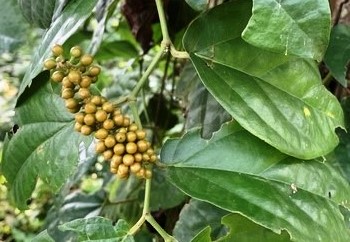Piper guineense

|
|
Piper guineense Common Names: West African black pepper, Climbing
black pepper, Ashanti pepper, Guinea pepper, Uziza Scientific
Classification Kingdom: Plantae Clade: Tracheophytes Clade: Angiosperms Clade: Magnoliids Order: Piperales Family: Piperaceae Genus: Piper Species: P. guineense Binomial Name: Piper guineense Schumach. & Thonn. Synonyms: Piper clusii C.DC., Piper leonense C.DC., occasionally misidentified as Piper nigrum in early literature Morphological Description Piper guineense is a perennial climbing vine native to West Africa, reaching
heights of 10–20 m with adventitious roots aiding its ascent. It is
characterized by: · Stem: Woody, slender, twining, with a rough texture and occasional
nodes bearing roots · Leaves: Alternate, ovate to elliptic (5–15 cm long, 3–7 cm wide),
dark green, glossy, with a peppery aroma when crushed · Flowers: Small, greenish-yellow, arranged in axillary spikes (3–6 cm
long), producing clusters of fruits · Fruit: Small, spherical berries (3–5 mm in diameter), green when
unripe, turning reddish-brown to black when mature and dried Distribution and Habitat Piper guineense is indigenous to the tropical rainforests of West and
Central Africa, spanning Nigeria, Ghana, Cameroon, Sierra Leone, Côte d’Ivoire,
and extending to the Democratic Republic of Congo. It thrives in: · Humid Forests: Prefers shaded understories with high humidity (70–90%) and
temperatures of 25–35°C · Cultivated Areas: Commonly grown in home gardens, small
farms, and agroforestry systems · Soil Conditions: Flourishes in well-drained, loamy soils
rich in organic matter (pH 5.5–6.5) Its adaptability to
shaded, humid environments has made it a staple in both wild and cultivated
settings (Oyemitan, 2017). Ethnopharmacology Piper
guineense, commonly known as African black pepper or Ashanti pepper, is a
climbing plant native to West Africa, valued for its culinary and medicinal
applications. Rich in bioactive compounds such as alkaloids, flavonoids, and
essential oils, it exhibits a range of therapeutic properties. Traditionally,
it has been utilized for its antibacterial and antifungal effects, particularly
in treating infections like skin rashes, oral thrush, and vaginosis. Its
antioxidant activity, attributed to compounds like piperine, helps neutralize
free radicals, potentially reducing oxidative stress. The plant also
demonstrates anti-inflammatory properties, making it beneficial in alleviating
conditions such as rheumatism and muscle cramps. Additionally, Piper guineense
has shown anticonvulsant activity, suggesting potential in managing seizure
disorders. Its hypolipidemic effects contribute to cardiovascular health by
lowering cholesterol levels and aiding in weight management. In traditional
Nigerian medicine, the leaves are consumed to enhance female fertility, and the
plant is believed to boost male fertility due to its zinc and magnesium
content. Furthermore, the presence of piperine is associated with cognitive and
mood benefits, indicating potential in managing depression and improving
cognitive function. While these medicinal attributes highlight the therapeutic
potential of Piper guineense, further clinical research is necessary to fully
establish its efficacy and safety profiles. · Digestive Health: In Nigeria, leaf infusions treat
stomachaches and constipation. The fiber content (8–10 g/100 g) and carminative
piperine (5–9%) enhance digestion and reduce bloating (Mgbeahuruike et al.,
2019). · Anti-inflammatory: In Ghana, fruit decoctions manage
arthritis. Methanol extracts inhibit paw edema by 40–60% in rats at 200 mg/kg,
linked to piperine and β-caryophyllene (Akinloye et al., 2020). · Antimicrobial: In Cameroon, seeds combat infections. Ethanol extracts
inhibit Staphylococcus aureus (MIC 78 µg/mL) and Candida albicans (MIC 39 µg/mL), due to piperlongumine
(Mgbeahuruike et al., 2017). · Antidiabetic: In Côte d’Ivoire, leaf teas regulate blood sugar. The ethyl
acetate and n-butanol fractions with IC50 value of 0.24 ± 0.07 and
0.83 ± 0.15 μg/mL respectively elicited significant inhibitory activities
against α-glucosidase while only n-butanol fraction (IC50 = 0.33 ± 0.09 μg/ml)
exhibited appreciable inhibition against α-amylase activity (Sulaimon et al.,
2020). · Reproductive Health: In Nigeria, seeds enhance libido and
postpartum recovery. Ethanol extracts increase uterine contractions by 50–70%
in rats, supporting oxytocic use (Udoh et al., 1999). · Anticonvulsant: In Benin, fruit extracts treat seizures. Essential
oils protect 62–100% of mice against PTZ-induced convulsions at 200 mg/kg (Ngo
Bum et al., 2009). ⚠ Toxicity Profile: Generally safe in culinary amounts (LD₅₀ >
5,000 mg/kg in rats), excessive intake (>1 g/kg) may cause gastrointestinal
irritation. Its oxytocic properties contraindicate use in pregnancy due to
potential uterine stimulation (Williams et al., 2013). Phytochemistry The plant’s bioactivity
arises from its rich phytochemical profile: · Alkaloids: Piperine (5–9%), piperlongumine, responsible for pungency
and antimicrobial effects · Volatile Oils: β-sesquiphellandrene (20.9%), linalool (6.1%), limonene
(5.8%), driving aroma and CNS activity · Flavonoids: Quercetin, kaempferol (0.1–0.5%), with antioxidant
properties · Terpenoids: β-caryophyllene, aiding anti-inflammatory effects These compounds,
identified via GC-MS, underpin its therapeutic versatility (Oyemitan et al.,
2015). Additional Uses · Culinary: Fruits and leaves flavor soups, stews, and teas across West
Africa · Cultural: Used in Nigerian rituals for its perceived protective
properties · Economic: Seeds traded locally, supporting rural livelihoods References
External Links More Pictures |
|
| Compounds of Piper guineense |
|
| References |